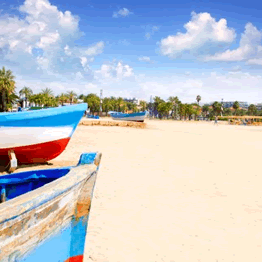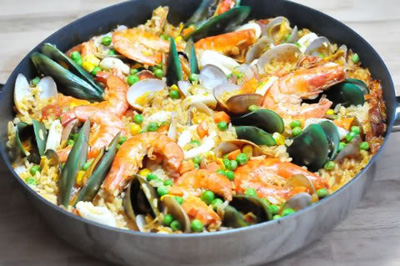 A couple of summer months filled with many beachside lunches of paella so good and so long ago that I am still chasing the memories of a perfect paella. My sister and I were in the Catalonian village of Arenys de Mar for a good part of the summer. On the wide, white beach surrounded by rugged hills were a handful of rustic 'restaurants' that made only paella over wood fires. They were makeshift structures covered with bright pieces of miss-matched canvas tacked down to keep the strong Spanish sun and ocean breeze at bay. These little makeshift restaurants were always busy for lunch, the only meal that they served and I had my favorite one.
A couple of summer months filled with many beachside lunches of paella so good and so long ago that I am still chasing the memories of a perfect paella. My sister and I were in the Catalonian village of Arenys de Mar for a good part of the summer. On the wide, white beach surrounded by rugged hills were a handful of rustic 'restaurants' that made only paella over wood fires. They were makeshift structures covered with bright pieces of miss-matched canvas tacked down to keep the strong Spanish sun and ocean breeze at bay. These little makeshift restaurants were always busy for lunch, the only meal that they served and I had my favorite one.
The beach side paella restaurateurs were waiting like gulls as the little boats motored back to port around 10 o’clock in the morning. Each boat filled with the fresh caught fish and shellfish still moving violently seeking to be set free. There was fish to fillet and chunk, stock to make, onions and peppers to chop and most importantly the wood-fire had to be started, time was of the essence.
My favorite restaurant had a round stone fire pit built on the sand. A variety of wood collected from the beach was piled into the pit covering yesterday's scrunched up newspaper which was barely visible in the center. A wooden match was struck and the day's cooking commenced. When the flames burned down, the cook balanced a grill on top of the stone pit.
A large battered and blackened pot half full of seawater was slid over the roaring fire; cups of peeled garlic cloves, mounds of chopped onions, chopped tomatoes and all the fish heads, bones and shrimp shells we're rhythmically tossed in. All the odds and ends from the daily catch found their way into the pot. The pot of stock was never allowed to boil once the seawater was poured into the caldron. It was hardly stirred to keep it from getting murky. As the fish water turned to stock and smelled less raw the seagulls overhead disappeared.
 I would start my long walk to the little restaurant when I saw the fishing boats heading towards the beach. That way I could have a choice table by the fire to watch the dance of the paella from the beginning. I’d positioned my chair perfectly to catch the breeze instead of the having the wood smoke finding me. First I ordered a cold bottle of local beer and buried my feet in the hot white sand, watching my feast from the start.
I would start my long walk to the little restaurant when I saw the fishing boats heading towards the beach. That way I could have a choice table by the fire to watch the dance of the paella from the beginning. I’d positioned my chair perfectly to catch the breeze instead of the having the wood smoke finding me. First I ordered a cold bottle of local beer and buried my feet in the hot white sand, watching my feast from the start.
When the stock was ready and everything else was chopped the waitperson came to take my order. Seafood paella, extra squid - I always ordered the same thing. Once my order was taken a small seasoned paella pan was removed from the stack kept in an old wooden box and placed over the hot fire.
A small amount of oil was poured out of a terra cotta jug as the cook waited for the empty pan to heat. The cook then added coarsely chopped garlic, green pepper and onions to the pan, stirring with a worn wooden spoon. He moved the pan to the cooler side of the fire and added chopped, fresh tomatoes and paprika, tending it over the flickering wood fire. He watched, waited and stirred. He knew when it was time to add the rice by the aroma and the darkening color of the sofrito.
From a repurposed plastic jug he poured the rice and combined it with the ingredients already in the paella pan. Never did he have to add more oil. It sizzled softly in the pan for at least 5 minutes until each kernel glistened. Next, saffron dissolved in a half cup of stock was carefully added. By the sound of the sizzle, he added the now done fish stock. Using an old chipped porcelain ladle the cook carefully dipped from the surface of the simmering stockpot. With his experienced eye he knew just the right amount of fish stock to add. When the stock was almost absorbed into the rice the cook added a touch more stock. He jockeyed the pan skillfully to a cooler spot just like he had done hundreds of times before. It was time to add the fish.
 He artfully arranged the pink shrimp, pieces of fish, clams, mussels and extra squid on the surface of the almost cooked rice. A wooden lid covered the pan and he never lifted it to check. He never took his eyes or ears off my lunch. When he heard the sizzle of the rice again he removed the pan immediately from the grill, removed the wooden lid placed it on a wooden board, sprinkled a handful of green peas on top and draped the pan with a heavy towel. By this point I could barely wait any longer for the magic moment when the towel would be lifted in front of me, my lunch would be served and the fragrant steam would be mine.
He artfully arranged the pink shrimp, pieces of fish, clams, mussels and extra squid on the surface of the almost cooked rice. A wooden lid covered the pan and he never lifted it to check. He never took his eyes or ears off my lunch. When he heard the sizzle of the rice again he removed the pan immediately from the grill, removed the wooden lid placed it on a wooden board, sprinkled a handful of green peas on top and draped the pan with a heavy towel. By this point I could barely wait any longer for the magic moment when the towel would be lifted in front of me, my lunch would be served and the fragrant steam would be mine.
I loved my primal routine, every minute of it! From the sight of the boats making their way home, my walk to the little restaurant, getting there early enough to watch and smell the whole process from start to finish.
I would go alone. I prefer to eat paella by myself; slowly, systematically, with no need to rush. A big bite of squid, a forkful of rice, a delicate squeeze of lemon, the ocean breeze. All those lunches have kept me content enough for the rest of my life because I have experienced ‘perfect’ paella.
As my paella pan slowly emptied I was careful not to let my fork go too deeply to disturb the socarrat yet; the caramelized layer of rice crust on the bottom of a ‘properly’ made paella. This was my dessert. I would eat the rice crust slowly, not worrying that it was no longer warm, sit back in my wobbly chair and chipped away.
I’d watched the waves break feet away and I was thankful that the sea and a caring cook had given me so many wonderful lunches.
Brenda Athanus runs a small gourmet food shop in Belgrade Lakes, Maine with her sister Tanya called the Green Spot.
The Green Spot
This email address is being protected from spambots. You need JavaScript enabled to view it.
207.441.9327

